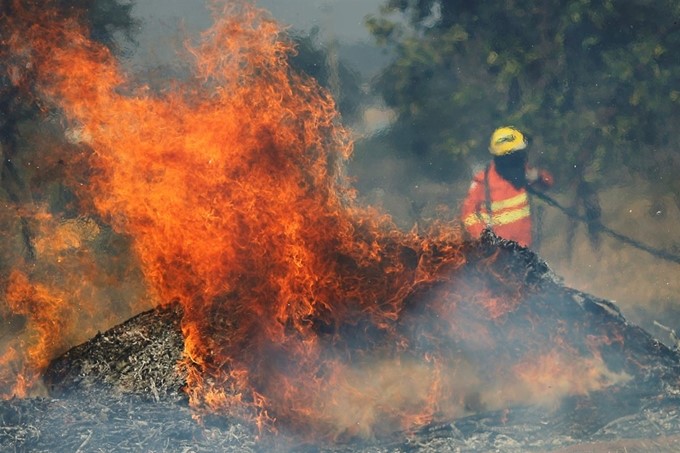This summer a huge forest fire consumed the Amazon Rainforest making headlines worldwide. On August 20, Brazilian media EXAME reported the blaze calling it the worst fire in recent history, setting off a global struggle to extinguish it. The fires have reached the triple shared border of Brazil, Bolivia and Paraguay, with 20,000 hectares of forestry ablaze. Many countries have sent troupes to assist with the situation, hoping to save as much as possible, rescuing greenspace, animals and indigenous tribes. The main cause of the fire is illegal deforestation, accelerated by the dry weather. This issue became a hot topic on the internet, because it was not reported by both local and mainstream media until it reached a critical stage.
 |
| ▲ Brazilian President who delayed the fire extinguishing. (Photo from The New York Times) |
The Amazon rainforest is a dense tropical rainforest located in the northern region of South America, also known as the Amazon basin. It’s an area 79 times the size of South Korea. It has been dubbed, “the lungs of the earth” since it releases one-third of the planet’s oxygen. Some analysts blame the increasingly dry environment on climate change and suggest this is why forest fires are becoming more frequent in the Amazon. However, local civic groups and environmental experts assert that the fire in the forest is burning rapidly because of the development of soybean cultivation, which is used to feed livestock and the expansion of pastures required for stockbreeding production. The current fire is turning a section of the rainforest, which is 1.5 times larger than a soccer field, into black ashes, covering the sky over Sao Paulo in Southern Brazil which is 3,000km away from Amazon with black smoke. The air pollution can also be seen from space. Amazon fires have already destroyed about 20 percent of the rainforest’s ecosystem. If this rate is sustained, Amazon will soon be transformed from a rainforest to a grassland. As of July 2019, the rate of destruction in the Amazon increased by 278 percent as compared to the previous month. On September 5, resident aborigines declared “a day for the survival of the natives of Amazon” and launched a mass rally to ward off their possible extinction.
Environmental groups and the Brazilian President are divided over the real cause of the Amazon fire. Environmental groups blame the president for pushing ahead with development first policies such as attracting local economic investment, saying Brazil’s president instigated farmers and loggers to set fires to develop the Amazon. In response, the Brazilian president argued that the forest fires only occurred in areas that were already cleared of logging, arguing that foreign involvement in the Amazon wildlife is a violation of their political sovereignty.
In response, the international community strongly criticized the president. The government of France said they would not approve the signing of a free trade agreement in the EU’s South American market, while Norway insisted that they would stop donations to the Amazon Fund, a body created to protect the rainforest. The German government said it would cancel plans to invest 505 million Reals for protection of the forest. Under pressure from the international community, the Brazilian president approved the deployment of troops to help put out the fire. However, during the three weeks that Brazil was standing on the sidelines, 15 to 17% of the rainforest’s ecosystem was damaged.
To learn more about the topic, The Dankook Herald interviewed Kim Choony, vice-president of the Korean Federation for Environmental Movements. When asked about the global impact of the fire outbreak, she explained, the rate of carbon absorption by the Amazon forest will be greatly reduced, having a big impact on climate change. The more the forest is cut off, the less it will be able to absorb moisture in the atmosphere, making it even more vulnerable to drought and fire. According to experts who have been studying the Amazon, it will take 20 to 40 years to restore these losses if it is even possible. The problem is that the remaining trees are more prone to drought and continuous fires.
Emphasizing the Amazon’s role as a home to one million indigenous people, she stated that it maintains not only a huge portion of the world’s biodiversity, but also diverse lives and cultures of mankind. When forests are cut down or destoyed, the base where people live is destroyed, with the civilization of mankind retreating accordingly. According to our interviewee, the major cause of the fire in the Amazon is commercialized farming, which requires landowners to cut down trees producing timber and to burn the forest to make room for large-scale farms where they can raise cows or cultivate beans. She argued university students to do their part by saving paper, reducing their consumption of meat and using public transportation as much as possible. She also said that it is essential for them to keep an open mind when it comes to the environment, keeping an eye on the efforts of environmental organizations and supporting their activities. Lastly, she explained that global slogans and actions to save the Amazon are still important since the Brazilian government is much more sensitive to the pressures of the international society than the internal pressures of ordinary Brazilians.
Even if the forest does regrow and regenerate, researches have stressed that the surviving plants from this fire will be more prone to fires in the future. This issue will keep repeating itself and will be difficult to prevent if no actions are taken. Apart from the pressing political pressure from other countries, famous clothing brands like ‘H&M’ and ‘The North Face’ are currently banning Brazilian leather due to alleged involvement in the forest fires. 80% of forest fires are caused by the cattle industry in order to create space for their livestock, so we should all do our part in saving the world. Small initiatives like consuming plant-based milk (soymilk, almond milk, coconut milk, etc.) instead of animal milk, cutting down on beef or red meat intake, recycling, reusing and repurposing paper products, banning leather products and other animal products can all help improve this situation. The forest might seem far away from us, but it is home to many animals and people and has the capacity to affect our daily lives. It is important for us, as people, to try our hardest to solve this problem together.
 |
| ▲ A firefighter is putting out the fire at the Amazon rainforest in Brazil. (Photo from hankookilbo) |
남윤경, Mak Haoyang, 나승민, 이지희 dankookherald@gmail.com

![[Campus Magnifier] Let's Surf the Library!](/news/photo/202404/12496_1765_4143.jpg) [Campus Magnifier] Let's Surf the Library!
[Campus Magnifier] Let's Surf the Library!
![[Campus Magnifier] Let's Surf the Library!](/news/thumbnail/202404/12496_1765_4143_v150.jpg)





